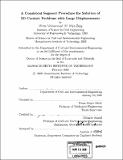| dc.contributor.advisor | Klaus-Jürgen Bathe. | en_US |
| dc.contributor.author | Baig, Muhammed Ali Ifran, 1976- | en_US |
| dc.contributor.other | Massachusetts Institute of Technology. Dept. of Civil and Environmental Engineering. | en_US |
| dc.date.accessioned | 2006-11-07T16:44:43Z | |
| dc.date.available | 2006-11-07T16:44:43Z | |
| dc.date.copyright | 2006 | en_US |
| dc.date.issued | 2006 | en_US |
| dc.identifier.uri | http://hdl.handle.net/1721.1/34643 | |
| dc.description | Thesis (Sc. D.)--Massachusetts Institute of Technology, Dept. of Civil and Environmental Engineering, 2006. | en_US |
| dc.description | Includes bibliographical references (leaves 142-146). | en_US |
| dc.description.abstract | Solution of contact problems in solid mechanics using the finite element method is a challenging and non-trivial task. Stable and efficient contact algorithms are required for effective solution of general problems. In this thesis, a general algorithm is presented for the analysis of contacting bodies undergoing large displacements. A sub-segment approach is adopted, which allows the algorithm to pass the contact patch test. Passing the patch test is a fundamental requirement for optimal convergence of the finite element solution. The algorithm is a Lagrange-multiplier based one, with the contact tractions as the additional variables to be solved for. Interpolation orders for which the resulting mixed formulation remains stable and optimal are used to interpolate the contact traction variables. The inequality constraints arising in contact conditions are regularized using the constraint function method. Implicit time integration schemes are attractive for dynamic analysis of structures and solids when the response lies in the lowest few modes. But the schemes then have to be unconditionally stable to be able to utilize reasonably large time step sizes. Widely used schemes that are unconditionally stable in linear analysis, do not remain so in nonlinear analysis. A simple composite direct time integration scheme is presented which remains stable for long duration analyses involving large displacements. The nature of the method also makes it attractive for use in dynamic analysis involving contact. The numerical schemes presented are validated using example problems. | en_US |
| dc.description.statementofresponsibility | by Mirza Muhammad Ali Ifran Baig. | en_US |
| dc.format.extent | 146 leaves | en_US |
| dc.format.extent | 5804390 bytes | |
| dc.format.extent | 5804258 bytes | |
| dc.format.mimetype | application/pdf | |
| dc.format.mimetype | application/pdf | |
| dc.language.iso | eng | en_US |
| dc.publisher | Massachusetts Institute of Technology | en_US |
| dc.rights | M.I.T. theses are protected by copyright. They may be viewed from this source for any purpose, but reproduction or distribution in any format is prohibited without written permission. See provided URL for inquiries about permission. | en_US |
| dc.rights.uri | http://dspace.mit.edu/handle/1721.1/7582 | |
| dc.subject | Civil and Environmental Engineering. | en_US |
| dc.title | A consistent segment procedure for solution of 2D contact problems with large displacements | en_US |
| dc.type | Thesis | en_US |
| dc.description.degree | Sc.D. | en_US |
| dc.contributor.department | Massachusetts Institute of Technology. Department of Civil and Environmental Engineering | |
| dc.identifier.oclc | 70125340 | en_US |
